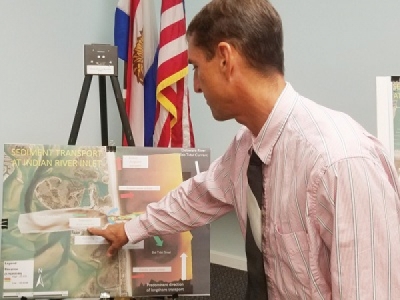
Posted on September 24, 2018
This winter, the Department of Natural Resources & Environmental Control (DNREC) will kill two birds with one stone. While dredging Massey’s Ditch, engineers will pump the displaced sand onto the beach north of the Indian River Inlet.
Officials with DNREC’s Shoreline & Waterway Management Section explained the scope of the maintenance dredging project at an informal informational meeting held Sept. 17 at the South Coastal Library in Bethany Beach.
“The key goal of the project is to improve navigation at low tide for boaters,” said Program Administrator Mike Powell, “and to provide a good source of material for beach nourishment for a critical part of the coastline that has been challenged for sand quantity in Delaware Seashore State Park.”
Members of the public were able to view the maps, make comments and ask questions at the meeting.
The “beneficial reuse” project is anticipated to start early in the winter of 2019, pending permits. Massey’s Ditch is a “federally identified channel that has been maintained by DNREC. The dredging program is in the Division of Watershed Stewardship,” Powell explained.
Even where the channel marked, it can get particularly low at low tide.
During the dredging, a hydraulic cutter head dredge will do the heavy lifting, while a series of pipes will float along the shoreline, dip under the road and carry the sand to the park — possibly right into the surf zone. Dunes are not currently part of the project but could potentially be added if a storm removed a critical amount, Powell said.
Ever since the Indian River Inlet was stabilized in 1938, the beaches have been affected by the simple addition of those now 80-year-old jetties. Stretching into the ocean, the jetties block the natural littoral movement of sand northward up the coastline. As a result, the south side has built out naturally, while the north side shriveled.
Currently, a pipe helps restore some of the sand flow by physically pumping sand north across the inlet bridge. The pipe hangs from the bridge span, just out of motorists’ eyesight. Although the goal is to move at least 80,000 cubic yards of sand annually, the south side has also lacked the sand to meet that quota for the past three years. In 2014, 500,000 cubic yards replenished the beaches, dug from shoals just inside the Indian River Inlet.
“So many factors are driving the movement of sand in this area,” Powell said of the standard erosion, northbound littoral movement, inlet tides that deposit sand in shoals, Delaware River tides and the sand bypass system. “We’re depositing that sand in an area where some of it may … work its way back to the inlet area and the north beach.”
The project will occur sporadically across Massey’s Ditch, which measures about 2.7 miles long and 100 feet wide. The ideal channel depth is about 6.5 feet MLLW, said consultant Peter Kotulak, a coastal engineer for Moffatt & Nichol of Baltimore.
The project is currently more than two-thirds designed. Bid documents will be prepared in December, with the work expected to occur between January and March. The sand should settle by Memorial Day, officials said.
DNREC will hire an outside contractor for the job. Although the exact cost of the project won’t be known until the bids are opened, DNREC staff estimated that cost as around $3.5 million to $4 million. Although no federal funding is expected, an increase in boater license and registration fees in 2017 has since been funding a waterway maintenance fund, and that will help, as will some beach-fill funding.
The project has long been needed, said angler and advocate Rich King. It would be dangerous not to dredge, he said.
“If you’re in a boat, and you hit a sand bar” going full speed, King said, people will die.
He also noted that the inland bays already have poor flushing, so all the bacteria, human and animal waste, which foul the bays, would be trapped even longer if one more solid storm silted up Massey’s Ditch. That also harms anyone who makes a living on the water.
“These bays have reached a breaking point,” King said, so he believes any project will help.
Some of those present at the Sept. 17 meeting said they were concerned that dredging would create a vacuum that would pull more sand from desirable formations (such as Lynch Thicket).
Others said they were upset that some sandbars would still block nearby channels, but Kotulak emphasized that those areas weren’t part of the project scope, which is to return Massey’s Ditch to its intended layout.
Meanwhile, state Sen. Gerald Hocker Sr. said underwater components of the old inlet bridge still need to be removed to help slow erosion there. Sampling has showed that the underwater material there averages at least 88 percent sand, and mostly 95 to 99 percent sand, and any metal particles tested below state standards.
Private groups can also request to dredge waterways. Nearby, the Rehoboth Bay Sailing Association near Dewey Beach is planning a maintenance dredging project of their own. Powell said nothing prevents them from contacting the future Massey’s Ditch project contractor to ask about piggybacking their project while the dredge is nearby. As for pumping their dredged material to the beach, they’ll need to contact DNREC about sampling the material.
The Sept. 17 meeting is likely to be the full extent of major public outreach for the project. A public hearing won’t be held unless the permitting agencies hear significant demand during the public comments process.
The public can comment when the project enters the permit process for the DNREC’s Wetlands & Subaqueous Lands Section and for the U.S. Army Corps of Engineers’ Philadelphia District. Information will be posted in the state and federal registers.
Source: Coastal Point





